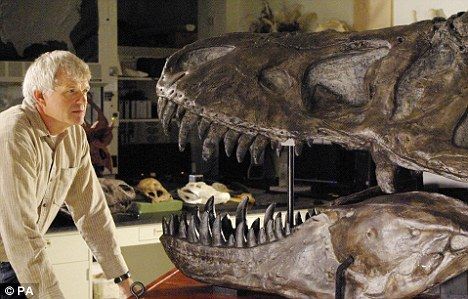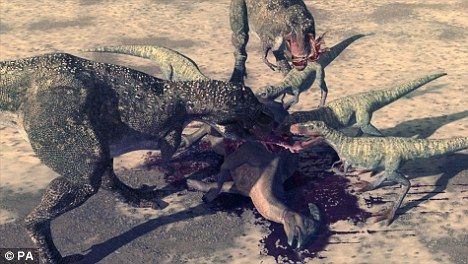
Scientists believe they have evidence that the top predator dinosaurs were highly intelligent pack animals, despite T-rex being popularly depicted as a dangerous but dim-witted loner.
This is a myth that has grown up because for many years their fossil skeletons tended to be found on their own, researchers say.
The new theory follows an analysis of skeletons of the tyrannosaur Tarbosaurus bataar from 90 sites in the Gobi Desert, Mongolia.
Tarbosaurus, a cousin of T-rex that lived around 70 million years ago, was a two-legged predator up to 12 metres long and weighing five tonnes.
At least half a dozen of the animals appear to have belonged to a single social group, including adults and juveniles, that died together.

At a site on the Red Deer River, Alberta, his team uncovered the bones of up to two dozen Albertasaurus specimens.
There was insufficient evidence then to prove the dinosaurs were from a single group, but several of the Gobi Desert skeletons were found lying side-by-side in the same rock layers, implying that they died together.
Most experts have assumed that pack hunting evolved with the rise of mammals. Dinosaurs were not thought to have had enough intelligence to behave like modern-day wolves.
But according to Prof Currie, from the University of Alberta, tyrannosaurs had all the necessary qualifications for pack hunting, including speed, keen senses and a highly developed brain.
Further research involving CT scans of tyrannosaur skulls indicated highly developed senses for hunting, and enough brain power for co-ordinated pack behaviour.
Three-dimensional tyrannosaur skull casts showed that the creatures' brains were roughly three times larger than those of other dinosaurs living at the same time.
Prof Currie believes tyrannosaurs probably hunted in groups with adults and juveniles adopting different roles.
The swifter, more agile young dinosaurs would have chased down potential prey, leaving the adults to deliver crushing fatal bites.
"Tyrannosaurids, I believe, were far more complex and more dangerous than we ever could have imagined," said Prof Currie, whose theory and research are the subject of a new documentary film, Dino Gangs.
"I believe these tyrannosaurids hunted in deadly, bloodthirsty packs. It's definitely time to rewrite the dinosaur books."
Dino Gangs will be shown in the UK on the Discovery Channel on Sunday June 26.
A book entitled Dino Gangs by best-selling author Josh Young will be published by Harper Collins on May 26.



Reader Comments
to our Newsletter